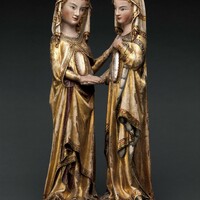Visitation sculpture
Type:
Sculptures
Date:
ca. 1310–20
Location or Findspot (Modern-Day Country):
Switzerland,
Germany
Medium:
Wood,
Rock crystal,
Gilt-silver
Dimensions:
59.1 × 30.2 × 18.4 cm
Description:
These painted and gilded figures, which are carved in walnut and inset with rock crystals, represent Mary and Elizabeth during the Visitation. In Christianity, this is the name given to moment when Mary, pregnant with Jesus, visited her cousin Elizabeth, who was pregnant with John the Baptist (described in Luke 1:39–56). The sculpture was intended for a female audience. It is attributed to Master Heinrich of Constance (Germany), and was created for the nearby Dominican convent of St. Katherinenthal.
Mary places her hand on Elizabeth's shoulder and Elizabeth holds a speech scroll that reads, "From where [is] this, to me, that the mother should come?" (Luke 1:43), or, in other words, "Who am I, that the mother of the Lord should visit me?" Behind the rock crystals, there may once have been images of the infant Jesus and John. The crystal invited the nuns of Katherinenthal to peer inside the women's bodies as if through windows, but the materiality of the crystal also conveyed ideas about the purity of these particular wombs.
Mary places her hand on Elizabeth's shoulder and Elizabeth holds a speech scroll that reads, "From where [is] this, to me, that the mother should come?" (Luke 1:43), or, in other words, "Who am I, that the mother of the Lord should visit me?" Behind the rock crystals, there may once have been images of the infant Jesus and John. The crystal invited the nuns of Katherinenthal to peer inside the women's bodies as if through windows, but the materiality of the crystal also conveyed ideas about the purity of these particular wombs.
Relevant Textbook Chapter(s):
10
Repository and Online Resources:
• Read more and watch a video about these figures on the website of the Metropolitan Museum.


